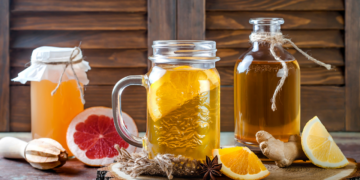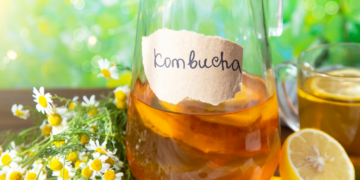How much would you pay for a tea made with panda poop? How about a tea that is harvested with golden scissors?
Sitting down to enjoy a cup of tea can be one of life’s great experiences, and people who love tea are often enthusiastic about finding new and interesting varieties. But, not all tea is created equal, and factors like where the tea is grown, how it is harvested, and what happens afterward all make a big difference in the final product that ends up in your cup.
Here are some of the teas processed in very unusual or complicated ways that many tea enthusiasts are willing to pay a lot of money for the privilege of having a sip. Bear in mind that these teas can be a little pricey that you may find that some of them are better for window shopping than for actually tasting!
Yak Butter Po Cha

Butter tea is a creamy, Himalayan drink that gets its name from the butter derived from yak milk. It starts with a black tea from China, called pu’erh which is allowed to age and ferment, like wine or cheese, until complex flavors develop. The tea is then brewed in salt and then poured over the yak butter, and finally blended with milk curds. The end result is a tea that is warm and filling in the thin, cold air of Tibet.
The tea and yak’s milk are both expensive, so the drink is reserved for special occasions in most families.This tea is also known as Tibetan butter tea or po cha and is one of the rarest in the world, since all of the ingredients needs to be sourced from specific areas of Tibet to be authentic.
To truly understand the work and process used to make this complicated and exclusive brew, check out the video below:!
As to how it tastes, most drinkers of this tea note its strange salty taste as it often takes a little getting used to. It is difficult to source this tea online so imitations have been made for the mass market. There is even a guide to making Tibetan yak tea at home with more common ingredients.
Panda Dung Tea

This tea is grown in the mountains of Sichuan, and its most important characteristic is that it is fertilized with panda dung. Because pandas only digest a small portion of their food, enthusiasts believe that the tea carries the health benefits of the bamboo consumed by pandas.
The tea was popularized by a university lecturer in Sichuan. These days, locals all dress up as pandas and participate in an annual tea-picking festival. During the festival, everyone heads out to a local plantation to pick the special panda-fertilized tea leaves.
You can buy a cup of this most expensive tea for around $200, or a pound for a shocking $35,000, making it a ludicrously expensive and rare tea that most of us will probably never get to try.
Silver Tips Imperial Tea

Silver tips imperial tea is a white oolong tea grown in the Makaibari Tea Estates in Darjeeling, India. Like other oolong teas, the leaves are left to oxidize for long periods of time before being shaped into twists for brewing. The tea is picked around midnight under a full moon during the summer solstice by a handful of carefully trained women — it’s easy to see why this tea is hard to get your hands on, since it can only be picked once a year. It is meant to be sipped before bed and is said to put the drinker in balance with the rhythm of the moon and sun.
In 2014, only three buyers in the world got some of these ultra rare tea leaves. The prices were the highest ever recorded for the sale of Indian tea. At SilverTipsTea, a limited amount of the record-breaking tea was put on sale.
While this tea is pretty rare, it’s a bit more affordable than the panda dung tea. At Makaibari, you can order this special tea for $30 per 50g.
Gyokuro

Gyokuro is a type of Japanese green tea that is grown only in the shade. This growing technique increases the caffeine and theanine, an antioxidant that drinkers believe to fight heart disease and cancer.
According to Tea Palace, gyokuro, or “jewel tea”, is one of the rarest and most expensive commercially sold teas in the world. It’s produced in very controlled conditions in a small part of Japan. The name means “dew of jade” and refers to the tea’s beautiful jade green color.
You can purchase some of this rare tea from Hibiki, a Japanese-based company, for $23 for 40g.
For a detailed look at the entire process end to end, take a look at this video below:
Vintage Narcissus
Vintage Narcissus is another oolong tea cultivated in the Wuyi mountains that is carefully oxidized to 60% and fired every two years to make sure the leaves are kept dry and not rotten. This tea is rare because it takes so long to create and is considered better with age.
Tea connoisseur alike describe it as elaborate, bold with flavors of wood, flowers, and chocolate, but based on the price few of us will ever get a chance to try it!
Some tea Vintage Narcissus tea can be more than fifty years old and often costs more than $6500 per Kilogram, making it one of the world’s most expensive teas.
Tieguanyin Tea

This tea is found in an area of China called Anxi. It is an oolong tea, but the leaves are not heavily oxidated. They are browned but still show some green. The tea is said to carry the scent of orchids. Enthusiasts believe it cleanses the blood and fights cancer.
In traditional production, only leaves and no buds are picked. The pickers use medium to large mature leaves. These leaves are then wilted in the sun, then moved indoors to continue the wilting process. After this, they are shamed 3-5 times. This part of the process requires training and skill.
This luxury tea is produced using an ancient traditional methods called ‘Baorou’, which is when withered, dry, oxidized leaves are wrapped in a cloth and rolled to create kitted pellets.
The name means “Iron Goddess of Mercy”. The tea is known for its thick, creamy texture and its strong, sweet flavor. Interestingly, this tea lasts for a long time, as it can be brewed multiple times. In fact, it is said to improve with multiple brews.
This tea is fairly easy to come by, but in its rarest and most luxurious form, it can be hugely expensive. In one record-breaking incident, a special variety of this tea sold from $3000 for a kilogram.
Yellow Gold Buds

This is a tea packaged and named by a company in Singapore called TWG. The tea leaves are grown on one side of one particular hill in Sichaun and are harvested only one night each year with a pair of golden scissors. They are then dried in a way that makes the leaves turn yellow, and each leaf is coated in 24 karat gold when it is ready to be brewed.
While the gold coating may sound extravagant, apparently, it can also provide some nutritional benefits.
Legend has it that this tea was once the tea of the Emperors of China. This tea is said to be the rarest and most expensive tea in the world. Today, the tea costs $150 for 50g.
Poo Poo Pu-erh
Pu-erh is a popular type of fermented tea grown in China, and some varieties are very rare. That’s the case with poo poo pu-erh, also known as grain moth tea. What makes this tea special is that it is made from the excrement of the grain moth after it has eaten the tea leaves.
Apparently, this tea is made up of tiny leaves and produces a dark, coffee-colored liquid With a smooth texture.
You’ll probably only find this tea available in small, old tea shops in China.
Tienchi Flower Tea
Tienchi flower tea is harvested from a type of ginseng plant in Hong Kong and is said to be useful in treating several health conditions, particularly rashes and other problems with the skin. People also say they drink this tea to help calm their nerves and fight insomnia.
It can usually only be found in specialty tea shops in Asia. The tea is incredibly rare as the Tienchi flowers only grow once every three years. If you’re desperate to try this tea, it can be bought only for $61 for 4 ounces.
Fresh Green Kukicha

This Japanese tea is different from many other varieties because the process of creating it involves more than just the leaves. The stems and twigs of the plant are also dried and added to the tea, giving it a more complicated flavor.
It is made during the production of Gyokuro, which is another rare shade-grown tea. Kukicha is known for having a very low caffeine content and a light, delicate taste.
It contains a large variety of minerals, vitamins, and antioxidants and is often used medicinally. It can be infused four times or more.
You’ll find this tea online for $90 for a pound.
Da-Hong Pao

This rare type of oolong tea is grown in the Wuyi Mountains of China and is sometimes called rock tea because of the rocky terrain where the plants grow. The bushes that the plant comes from are nearly 1,000 years old — plus, there are only three of them in the world, so it’s easy to see why this tea makes our list.
Oolong tea is made by letting the plants dry out and carefully allowing them to brown before they are twisted into tea leaves. This tea is one of the most expensive in the world at around $30,000 per kilogram.
You’ll probably struggle to find this tea anywhere in the states. If you’re ever in Fujian in southern China, you may be able to find a tea shop selling these pricey leaves.
PG Tips Diamond Tea Bag
PG Tips is a British tea company. If you know the brand, you may be wondering how they made the list — most of their teas are pretty unexciting and cheap. However, in honor of the company’s 75th anniversary, a Jeweler (Boodles Jewelers) created a super luxury, collector’s tea bag, which contained 280 diamonds on the outside. Inside the tea bag, is Silver Tips Imperial Tea, the rare Indian tea we discussed above.
So, how much will this tea set you back? A single tea bag costs $15,000! We aren’t sure whether anyone was crazy enough to actually purchase this tea bag, but we’d be shocked if they were.
Conclusion
There are more types of tea in the world than a tea lover can try in a lifetime. The location where the tea is grown, the harvesting and drying process, and what is added all make a huge difference in the end product. Whether you are interested in the health benefits of tea or simply enjoying the taste and aroma of this comforting drink, you will find all kinds of tea to try. If you are daring or curious and have some money to spend, enjoy a cup of one of these rare, unusual, and expensive teas.








